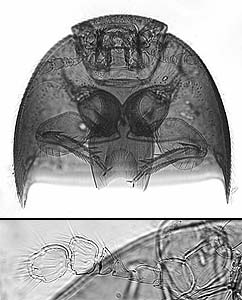Cephaloplectinae
W. Eugene Hall- Limulodes
- Rodwayia
- Paralimulodes
- Eulimulodes
- Cephaloplectus
Introduction
The subfamily Cephaloplectinae is currently composed of five genera (Cephaloplectus, Eulimulodes, Limulodes, Paralimulodes, Rodwayia) and approximately 37 species. The group is known to occur in North, Central and South America and Australia (Seevers and Dybas, 1943). All known host records associate these small beetles with ants ( Hymenoptera: Formicidae).
Characteristics
'Horse-shoe crab' beetles, a common name used for cephaloplectines (formerly Limulodidae), aptly describes their general form. Characteristics of the group include absence of eyes and hind wings; prothorax large, usually convex, ventrally possessing a 'prosternal lobe' that extends into region of meso/meta-sternum; elytra truncate, usually exposing terminal abdominal segments; antennae clavate, composed of 8 to 10 segments; mesosternum with elevated process between mesocoxae; metasternum extending between mesocoxae.
Geographical Distribution
Distribution records (Seevers and Dybas, 1943; Wilson et al., 1954) include: Cephaloplectus = Neotropical; Limulodes = Neotropical, Nearctic; Paralimulodes = Nearctic, Argentina; Eulimulodes = Mexico; Rodwayia = Australia.
Taxonomic History
Matthews (1867) described Limulodes, and placed the genus within Ptiliidae. Sharp (1883) described Cephaloplectus and placed the genus within Staphylinidae. Seevers and Dybas (1943) placed Limulodinae (Ptiliidae) and Cephaloplectinae (Staphylinidae) in a new family, Limulodidae, based on morphological analysis. Dybas (1976) continued to support Limulodidae as a separate though closely related family to Ptiliidae, based on adult and larval characters. Crowson (1981) and Lawrence and Newton (1982) suggested placing Limulodidae within Ptiliidae. Recent classifications (Lawrence and Newton,1995; Newton and Thayer,1992) retain Cephaloplectinae (=Limulodinae) as a subfamily within Ptiliidae.
Phylogenetics
Until a phylogenetic analysis has been completed, the relationship of Cephaloplectinae to other members of Ptiliidae remains unknown. A preliminary analysis of cephaloplectines is currently being conducted.
References
Crowson, R.A. 1981. The biology of Coleoptera. Academic Press, New York, xii + 802 pp.
Dybas, H.S. 1976. The larval characters of featherwing and limulodid beetles and their family relationships in the Staphylinoidea. Fieldiana 70(3): 29-78.
Lawrence, J.F. and A.F. Newton, Jr. 1995. Families and subfamilies of Coleoptera (with selected genera, notes, references and data on family- group names). In J. Pakaluk and S.A. Slipinski (ed.), Biology, Phylogeny, and Classification of Coleoptera: Papers Celebrating the 80th Birthday of Roy A. Crowson. pp. 779-1006.
Lawrence, J.F. and A. F. Newton, Jr. 1982. Evolution and classification of beetles. Annual Review of Ecology and Systematics, 13: 261-290.
Matthews, A. 1867. Description of a new genus of Trichopterygidae, lately discovered in the United States. Ann. Lyc. Nat. Hist. NY., 8: 406-413.
Newton, A.F., Jr. and M. K. Thayer. 1992. Current classification and family-group names in Staphyliniformia (Coleoptera). Fieldiana. Zoology. New Series, 67: 1-92.
Seevers, C.H. and H.S. Dybas. 1943. A synopsis of the Limulodidae (Coleoptera): A new family proposed for myrmecophiles of the subfamilies Limulodinae (Ptiliidae) and Cephaloplectinae (Staphylinidae). Annals of the Entomological Society of America, 36: 546-586.
Sharp, D. 1883. Subfamily Cephaloplectinae. In Biologia Centrali-Americana. Insecta. Coleoptera, vol. 1 (2). Taylor and Francis, London. pp. 295-297.
Wilson, E.O., T. Eisner and B.D. Valentine. 1954. The beetle genus Paralimulodes Bruch in North America, with notes on morphology and behaviour (Coleoptera: Limulodidae). Psyche: 154-161.
Title Illustrations

| Scientific Name | Paralimulodes wasmanni |
|---|---|
| Image Use |
 This media file is licensed under the Creative Commons Attribution-NonCommercial-ShareAlike License - Version 3.0. This media file is licensed under the Creative Commons Attribution-NonCommercial-ShareAlike License - Version 3.0.
|
| Copyright |
© 1997
W. Eugene Hall

|
| Scientific Name | Limulodes, Paralimulodes wasmanni |
|---|---|
| Body Part | head and prothorax (Limulodes), antenna (Paralimulodes wasmanni) showing only eight antennal articles |
| Image Use |
 This media file is licensed under the Creative Commons Attribution-NonCommercial-ShareAlike License - Version 3.0. This media file is licensed under the Creative Commons Attribution-NonCommercial-ShareAlike License - Version 3.0.
|
| Copyright |
© 1997
W. Eugene Hall

|
About This Page
W. Eugene Hall

University of Arizona
Page copyright © 1997 W. Eugene Hall
 Page: Tree of Life
Cephaloplectinae.
Authored by
W. Eugene Hall.
The TEXT of this page is licensed under the
Creative Commons Attribution-NonCommercial-ShareAlike License - Version 3.0. Note that images and other media
featured on this page are each governed by their own license, and they may or may not be available
for reuse. Click on an image or a media link to access the media data window, which provides the
relevant licensing information. For the general terms and conditions of ToL material reuse and
redistribution, please see the Tree of Life Copyright
Policies.
Page: Tree of Life
Cephaloplectinae.
Authored by
W. Eugene Hall.
The TEXT of this page is licensed under the
Creative Commons Attribution-NonCommercial-ShareAlike License - Version 3.0. Note that images and other media
featured on this page are each governed by their own license, and they may or may not be available
for reuse. Click on an image or a media link to access the media data window, which provides the
relevant licensing information. For the general terms and conditions of ToL material reuse and
redistribution, please see the Tree of Life Copyright
Policies.
Citing this page:
Hall, W. Eugene. 1997. Cephaloplectinae. Version 01 January 1997 (under construction). http://tolweb.org/Cephaloplectinae/9624/1997.01.01 in The Tree of Life Web Project, http://tolweb.org/










 Go to quick links
Go to quick search
Go to navigation for this section of the ToL site
Go to detailed links for the ToL site
Go to quick links
Go to quick search
Go to navigation for this section of the ToL site
Go to detailed links for the ToL site